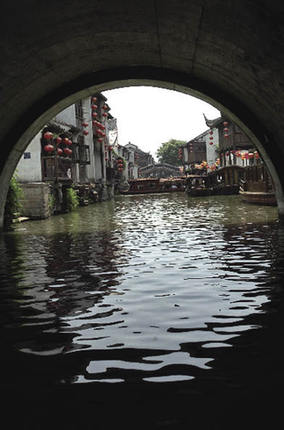| A Tour of Picturesque Jiangsu
By staff reporter QIAO TIANBI
AMERICAN Sinologist Philip Alden Kuhn described 17th-century South China thus, "The people's virtue is corrupted by extravagance like teeth are rotted by candy." As a matter of fact, the South China culture is the most exquisite and beautiful part of a culture known for countless forms of loveliness. In the 18th century, Emperor Qianlong (1711-1799) made six tours to South China, even ordering the construction of Suzhou Street in Beijing, a near-replica of a 300-meter-long waterside street in South China.Jiangsu, located mid-way down the east coast and cradled by the lower reaches of the Yangtze River, is one of the centers of South China culture. In the surrounding province, a plain covers 69 percent of the total territory, and water takes up 17 percent. The good natural environment makes the province a "land of fish and rice," and it hosts a rich civilization of long standing. Today's Jiangsu remains one of best developed provinces and boasts the highest population density. This is also the seat of Han (China's ethnic majority) culture and retains all its allure, with the Han making up 99.64 percent of the total population. A developed transportation network and thriving tourism industry mean the Jiangsu travel itineraries offer the most extravagant comforts and powerful aesthetics.
It takes only 40 minutes by train from Shanghai to Suzhou – one of the most ancient Chinese cities. Leaving cosmopolitan Shanghai behind, tourists can enjoy the more diminutive and equally famous pleasures of South China culture: small bridges, flowing streams and traditional houses.
 |
|
Perfectly preserved Shantang Street represents Suzhou's gentle streetscapes of yore. |
Shantang Street and Qinhuai River: Beauty of Waters
Shantang Street outside the Changmen Gate of Suzhou served as the prototype of Suzhou Street in Beijing's Summer Palace. Emperor Qianlong ordered its replication in Beijing because his mother often mentioned it after a visit she made there.
Shantang Street, labeled the "best known street in Gusu (Suzhou's ancient name)," has a history of more than 1,100 years. Houses are built facing the street, with their back clinging to a waterway. This was the place where merchants converged. Now, besides preserving its traditional streetscapes, the local people have also revived their folklore and customs. Lining the walkways are ancient theaters, traditional Suzhou teahouses, the Tingzhou Guildhall, and South China costume houses making the finery and accessories of the Ming and Qing dynasties available to the modern public. The whole street is simple in its classic and unadorned style, the architecture wearing basic tones of black, white and gray. Residences on the street were mostly built in the Ming and Qing dynasties, and are still inhabited by local people.
It was another South China city, Nanjing, some 200 kilometers from Suzhou, that was the cultural center of South China between the third and sixth centuries. The Qinhuai River, a tributary of the Yangtze rolls through Nanjing, and the section flowing through the walled downtown was called the Interior River. It is said that the first emperor of the Qin Dynasty toured here, so it got its name "Qinhuai." The Interior River is 4.8 kilometers long, and named 10-li Qinhuai (one kilometer = two li).
Starting in the third century, the area of Nanjing along the Qinhuai River was occupied by noble families in compact communities, and commerce was flourishing. In the 14th century, the Qinhuai River area reached its zenith. Now its best face is shown at night. Along the river burns a circus of dancing neon lights, and performances of ancient warfare revive ancient sights and sounds, only the growl of engines replaces the swish of oars.
Tourists can sample the best of Nanjing on an excursion ship to selected representative sites: Zhanyuan Garden, Confucian Temple, Egret Islet, Zhonghua Gate and the vistas from Peach Leaf Ferry to Zhenhuai Bridge. Each sight has its own legends and tales to stretch the imagination.
|
